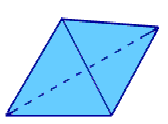
In Koch Snowflake we saw an interesting fractal snowflake-like object that is obtained when gluing smaller triangles iteratively to the sides of a big triangle.
So, what happens if you do something similar to a tetrahedron? That is, suppose you take a regular tetrahedron (all side lengths the same), and glue to each of its triangular faces some smaller regular tetrahedra, as in Figure 1? (Each smaller tetrahedron is scaled down by a factor of 1/2 from the larger one, and placed on each face in an inverted fashion, so that it divides the face into 4 equilateral triangles and covers the center one.)
Then iterate this process: at each stage, take the new object, and glue still smaller regular tetrahedra (scaled by 1/2 in the length of each side) on each of its triangular faces.
You might think that you get a very jagged object after all the stages are completed, but surprisingly, in the limit, you get a perfect cube!
Presentation Suggestions:
Draw a picture to help students to see what is going on. Challenge them to think about the object they get before telling them.
The Math Behind the Fact:
The cube you obtain has side length T/Sqrt[2], where T is the length of one of the edges of the regular tetrahedron you started with.
How to Cite this Page:
Su, Francis E., et al. “Koch Tetrahedron.” Math Fun Facts. <https://www.math.hmc.edu/funfacts>.
References:
R. Vakil, A Mathematical Mosaic, 1996.
Fun Fact suggested by:
Ravi Vakil

